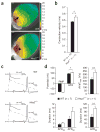Common variants at SCN5A-SCN10A and HEY2 are associated with Brugada syndrome, a rare disease with high risk of sudden cardiac death
- PMID: 23872634
- PMCID: PMC3869788
- DOI: 10.1038/ng.2712
Common variants at SCN5A-SCN10A and HEY2 are associated with Brugada syndrome, a rare disease with high risk of sudden cardiac death
Erratum in
- Nat Genet. 2013 Nov;45(11):1409. Borggrefe, Martin [added]; Schimpf, Rainer [added]
Abstract
Brugada syndrome is a rare cardiac arrhythmia disorder, causally related to SCN5A mutations in around 20% of cases. Through a genome-wide association study of 312 individuals with Brugada syndrome and 1,115 controls, we detected 2 significant association signals at the SCN10A locus (rs10428132) and near the HEY2 gene (rs9388451). Independent replication confirmed both signals (meta-analyses: rs10428132, P = 1.0 × 10(-68); rs9388451, P = 5.1 × 10(-17)) and identified one additional signal in SCN5A (at 3p21; rs11708996, P = 1.0 × 10(-14)). The cumulative effect of the three loci on disease susceptibility was unexpectedly large (Ptrend = 6.1 × 10(-81)). The association signals at SCN5A-SCN10A demonstrate that genetic polymorphisms modulating cardiac conduction can also influence susceptibility to cardiac arrhythmia. The implication of association with HEY2, supported by new evidence that Hey2 regulates cardiac electrical activity, shows that Brugada syndrome may originate from altered transcriptional programming during cardiac development. Altogether, our findings indicate that common genetic variation can have a strong impact on the predisposition to rare diseases.
Conflict of interest statement
The authors declare no competing financial interests.
Figures



References
-
- Brugada P, Brugada J. Right bundle branch block, persistent ST segment elevation and sudden cardiac death: a distinct clinical and electrocardiographic syndrome. A multicenter report. J Am Coll Cardiol. 1992;20:1391–1396. - PubMed
-
- Antzelevitch C, et al. Brugada syndrome: Report of the Second Consensus Conference Endorsed by the Heart Rhythm Society and the European Heart Rhythm Association. Circulation. 2005;111:659–670. - PubMed
-
- Chambers JC, et al. Genetic variation in SCN10A influences cardiac conduction. Nat Genet. 2010;42:149–152. - PubMed
-
- Holm H, et al. Several common variants modulate heart rate, PR interval and QRS duration. Nat Genet. 2010;42:117–122. - PubMed
Publication types
MeSH terms
Substances
Grants and funding
LinkOut - more resources
Full Text Sources
Other Literature Sources
Medical
Molecular Biology Databases
Miscellaneous

